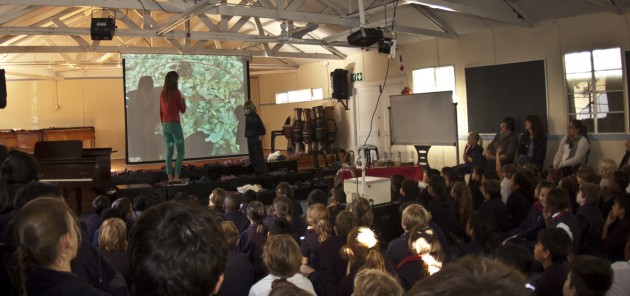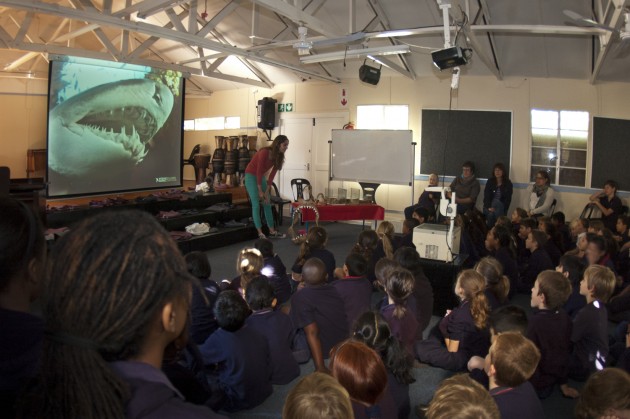Bringing the ocean to our classrooms …
If you can’t hold your breath and swim strongly, SCUBA dive or access a boat, our oceans will remain a largely intangible underwater world to most South Africans That is unless, of course, we bring our oceans ashore …
It’s not exactly the scientific side of our work this year with the False Bay survey, but I felt that the images, footage and information we’re bringing out the Bay needed to be shared – and right away!
The most receptive audience for our oceanic exploration? Well, I think the author and early transport rider, Sir Percy FitzPatrick, described this enchanting audience best when he dedicated his classic South African novel “Jock of the Bushveld” to the “likkle people” … His reason for dedicating his book of adventure in the African savanna to our youngest members of society? Why, their infinite capacity for wonder at our natural world, of course!
So, in turn, this blog post is to highlight the magical days I spent bringing our oceans into some Cape Town classrooms …
Some of my work prior to this False Bay survey had been focused on fostering environmental awareness amongst our youth. As part of this, I’d had the joy of being introduced to the Roots and Shoots programme by Dr. Jane Goodall on a visit of hers to Cape Town, and so it was in answer to a request from some Roots and Shoots schools in Cape Town that I put this little morning of ocean awareness together.
As a scientist, I’m acutely aware that tales of temperature loggers and complicated Latin species names can be a little dry to an audience outside the research realm …(!) So instead of a strict science lesson, the children of Forres Prep School in Rondebosch and the Noordhoek Montessori School were taken on an ocean safari … from the comfort of their classroom!
A quick photographic roundtrip introduced the children to the diversity of life in the waters off their home coastline … For many, this was a first-time glimpse into our marine protected areas – and some of the fish species were so new and strange that they elicited squeals of amazement that were serious encouragement to me!
We then plunged into the water together, harnessing our imaginations and holding our breath together as some video clips took the children on a “dive” with me into some of our most interesting marine protected areas around the Cape. First off, we headed out to visit the Cape Fur seals at Duiker Island in Hout Bay (where everyone under the age of 13 convinced me that they could hold their breath for the entire dive … some serious freedivers in the making!) and met some of the colourful creatures that share their home with the seals.
Next, it was off to discover shark diversity and to “swim” with the Sevengill sharks in their kelp kingdom… A couple of my “show and tell” items roused delighted shrieks – the shark teeth and jaws were a bit hit (especially when everyone got to run their fingers along those serrated edges). Who knew that sharks could be so diverse?
My favourite moment came from a child who asked me to, on my next visit to the Sevengills, name a shark on their behalf! Certainly, making sharks familiar characters goes a long way to fostering interest in and a love of our unusual creatures …

Not all sharks are large … A volunteer points out a tiny pufadder shyshark hidden amongst the shells and sand
At the end of the morning (after swimming with a few dolphins, meeting a Hawksbill turtle and a Bryde’s whale) we moved to our “rocky shores” and the children got up close with the invertebrate inhabitants of our rockpools. The prickly texture of a sea urchin, the slippery feel of a sea cucumber, the spiny armour of some little rock lobsters and the sticky tubefeet of a starfish … all these were new sensations to most.
Shrieks, squeals and grins all around!
In the end, we re-grouped for a more serious discussion around the conservation of our oceans – and our responsibility towards our sealife, particularly as South Africans who have inherited a phenomenal underwater heritage. In a strange turn of events, it was I who learnt the most from this session. You can imagine my delight when a 10 year old explained our Sustainable Seafood Initiative to everyone without any prompting from me – concluding, “the problem lies in sustainability. I only consider fish from the Green SASSI list”. Beach clean-ups and recycling – yes, the children all considered these wonderful ideas … but they’re a couple of steps ahead already, discussing issues of shark finning, sustainability and protection of our oceans for our future generations.
There’s something incredibly poignant about an 8 year old turning to me, wide-eyed and breathless after holding a starfish in their hands for the first time, to say “We need to look after our oceans so that other children after me can see them too!”
If these kids are anything to judge by, we have some wonderful conservation leaders growing up quickly. All the more reason to open their eyes to the extraordinary world beneath our waves … I simply cannot wait to show them the footage from the BRUVs as soon as our winter sampling trip is over!

Leave a Reply
You must be logged in to post a comment.